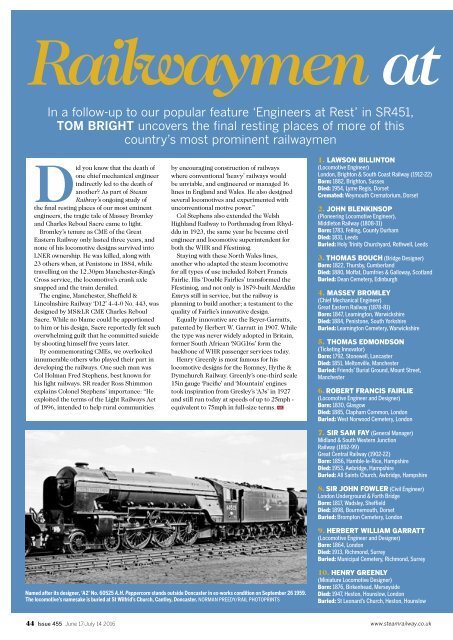Steam Railway Mini Magazine
Create successful ePaper yourself
Turn your PDF publications into a flip-book with our unique Google optimized e-Paper software.
<strong>Railway</strong>men at<br />
In a follow-up to our popular feature ‘Engineers at Rest’ in SR451,<br />
TOM BRIGHT uncovers the final resting places of more of this<br />
country’s most prominent railwaymen<br />
Did you know that the death of<br />
one chief mechanical engineer<br />
indirectly led to the death of<br />
another? As part of <strong>Steam</strong><br />
<strong>Railway</strong>’s ongoing study of<br />
the final resting places of our most eminent<br />
engineers, the tragic tale of Massey Bromley<br />
and Charles Reboul Sacre came to light.<br />
Bromley’s tenure as CME of the Great<br />
Eastern <strong>Railway</strong> only lasted three years, and<br />
none of his locomotive designs survived into<br />
LNER ownership. He was killed, along with<br />
23 others when, at Penistone in 1884, while<br />
travelling on the 12.30pm Manchester-King’s<br />
Cross service, the locomotive’s crank axle<br />
snapped and the train derailed.<br />
The engine, Manchester, Sheffield &<br />
Lincolnshire <strong>Railway</strong> ‘D12’ 4‐4‐0 No. 443, was<br />
designed by MS&LR CME Charles Reboul<br />
Sacre. While no blame could be apportioned<br />
to him or his design, Sacre reportedly felt such<br />
overwhelming guilt that he committed suicide<br />
by shooting himself five years later.<br />
By commemorating CMEs, we overlooked<br />
innumerable others who played their part in<br />
developing the railways. One such man was<br />
Col Holman Fred Stephens, best known for<br />
his light railways. SR reader Ross Shimmon<br />
explains Colonel Stephens’ importance: “He<br />
exploited the terms of the Light <strong>Railway</strong>s Act<br />
of 1896, intended to help rural communities<br />
by encouraging construction of railways<br />
where conventional ‘heavy’ railways would<br />
be unviable, and engineered or managed 16<br />
lines in England and Wales. He also designed<br />
several locomotives and experimented with<br />
unconventional motive power.”<br />
Col Stephens also extended the Welsh<br />
Highland <strong>Railway</strong> to Porthmadog from Rhydddu<br />
in 1923, the same year he became civil<br />
engineer and locomotive superintendent for<br />
both the WHR and Ffestiniog.<br />
Staying with these North Wales lines,<br />
another who adapted the steam locomotive<br />
for all types of use included Robert Francis<br />
Fairlie. His ‘Double Fairlies’ transformed the<br />
Ffestiniog, and not only is 1879-built Merddin<br />
Emrys still in service, but the railway is<br />
planning to build another; a testament to the<br />
quality of Fairlie’s innovative design.<br />
Equally innovative are the Beyer-Garratts,<br />
patented by Herbert W. Garratt in 1907. While<br />
the type was never widely adopted in Britain,<br />
former South African ‘NGG16s’ form the<br />
backbone of WHR passenger services today.<br />
Henry Greenly is most famous for his<br />
locomotive designs for the Romney, Hythe &<br />
Dymchurch <strong>Railway</strong>. Greenly’s one-third scale<br />
15in gauge ‘Pacific’ and ‘Mountain’ engines<br />
took inspiration from Gresley’s ‘A3s’ in 1927<br />
and still run today at speeds of up to 25mph -<br />
equivalent to 75mph in full-size terms. SR<br />
1. LAWSON BILLINTON<br />
(Locomotive Engineer)<br />
London, Brighton & South Coast <strong>Railway</strong> (1912-22)<br />
Born: 1882, Brighton, Sussex<br />
Died: 1954, Lyme Regis, Dorset<br />
Cremated: Weymouth Crematorium, Dorset<br />
2. JOHN BLENKINSOP<br />
(Pioneering Locomotive Engineer),<br />
Middleton <strong>Railway</strong> (1808-31)<br />
Born: 1783, Felling, County Durham<br />
Died: 1831, Leeds<br />
Buried: Holy Trinity Churchyard, Rothwell, Leeds<br />
3. THOMAS BOUCH (Bridge Designer)<br />
Born: 1822, Thursby, Cumberland<br />
Died: 1880, Moffat, Dumfries & Galloway, Scotland<br />
Buried: Dean Cemetery, Edinburgh<br />
4. MASSEY BROMLEY<br />
(Chief Mechanical Engineer)<br />
Great Eastern <strong>Railway</strong> (1878-81)<br />
Born: 1847, Leamington, Warwickshire<br />
Died: 1884, Penistone, South Yorkshire<br />
Buried: Leamington Cemetery, Warwickshire<br />
5. THOMAS EDMONDSON<br />
(Ticketing Innovator)<br />
Born: 1792, Stonewell, Lancaster<br />
Died: 1851, Meltonville, Manchester<br />
Buried: Friends’ Burial Ground, Mount Street,<br />
Manchester<br />
6. ROBERT FRANCIS FAIRLIE<br />
(Locomotive Engineer and Designer)<br />
Born: 1830, Glasgow<br />
Died: 1885, Clapham Common, London<br />
Buried: West Norwood Cemetery, London<br />
7. SIR SAM FAY (General Manager)<br />
Midland & South Western Junction<br />
<strong>Railway</strong> (1892‐99)<br />
Great Central <strong>Railway</strong> (1902-22)<br />
Born: 1856, Hamble-le-Rice, Hampshire<br />
Died: 1953, Awbridge, Hampshire<br />
Buried: All Saints Church, Awbridge, Hampshire<br />
8. SIR JOHN FOWLER (Civil Engineer)<br />
London Underground & Forth Bridge<br />
Born: 1817, Wadsley, Sheffield<br />
Died: 1898, Bournemouth, Dorset<br />
Buried: Brompton Cemetery, London<br />
9. HERBERT WILLIAM GARRATT<br />
(Locomotive Engineer and Designer)<br />
Born: 1864, London<br />
Died: 1913, Richmond, Surrey<br />
Buried: Municipal Cemetery, Richmond, Surrey<br />
Named after its designer, ‘A2’ No. 60525 A.H. Peppercorn stands outside Doncaster in ex-works condition on September 26 1959.<br />
The locomotive’s namesake is buried at St Wilfrid’s Church, Cantley, Doncaster. NORMAN PREEDY/RAIL PHOTOPRINTS<br />
10. HENRY GREENLY<br />
(<strong>Mini</strong>ature Locomotive Designer)<br />
Born: 1876, Birkenhead, Merseyside<br />
Died: 1947, Heston, Hounslow, London<br />
Buried: St Leonard’s Church, Heston, Hounslow<br />
44 Issue 455 June 17-July 14 2016<br />
www.steamrailway.co.uk

















